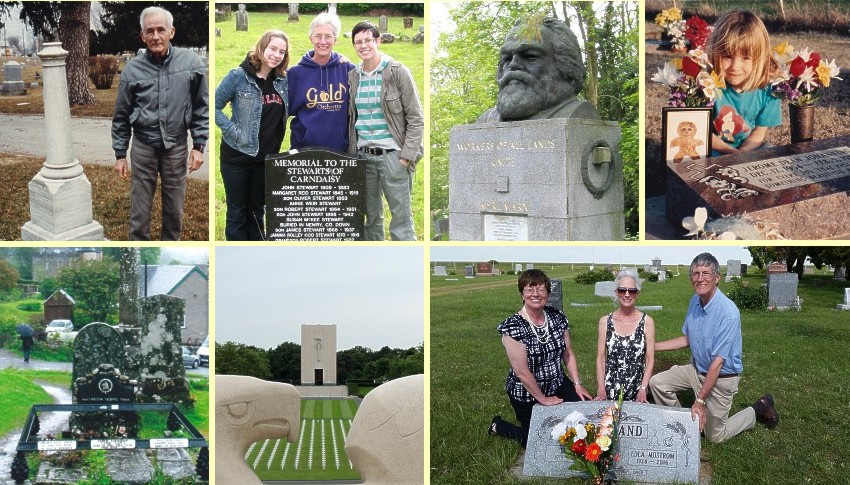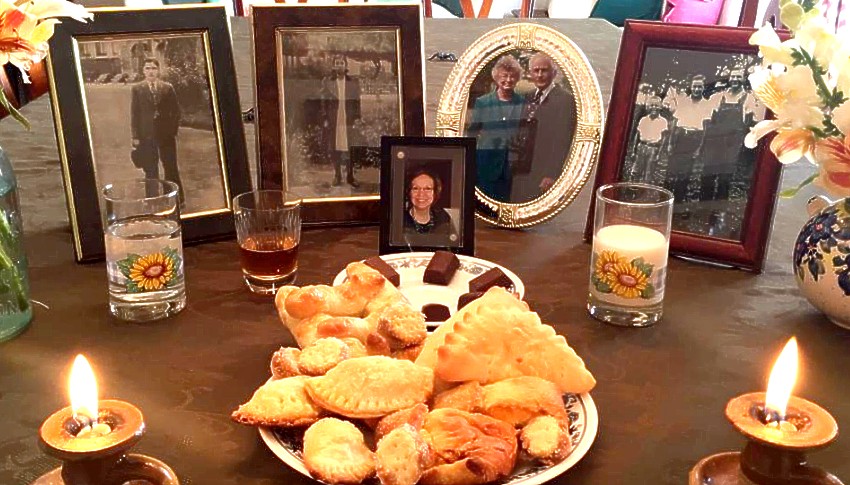Kansas Snapshots by Gloria Freeland - November 1, 2019
Comforting connection to the past
Halloween was yesterday and, along with ghosts and haunted houses, the holiday has long been paired with thoughts of creepy
cemeteries. My first memory of visiting a cemetery was at my Grandmother Hulda Mostrom's funeral in March 1961. I remember being cold and sad.
Now, I tend to find most cemeteries peaceful, and the inscriptions and designs on the gravestones interesting. Not only that, but
for family history nuts like Husband Art and me, many have yielded great information about family members. Records indicated that my
Great-Great Grandfather Samuel Freeland's middle name was Hawthorne. But a visit to his grave and subsequent research in Sterling,
Illinois showed that was wrong - it was Kirkwood.
But for those who cannot or do not want to visit in person, www.findagrave.com helps those who wish to locate the final resting
places of the rich, famous or just ordinary folks. According to the website, Jim Tipton created it in 1995. A music graduate of
Grinnell College in Iowa, he now lives in Utah and started it because "he could not find an existing site that catered to his
hobby of visiting the graves of famous people."
We like to visit in person and we're not only interested in family. We have walked military cemeteries honoring those killed in the
Civil War, World War I and World War II. Some were in the U.S., while others were in Luxembourg, Belgium, England, France and Germany.
We've also been to Highgate Cemetery in London, where Karl Marx is buried - one of Tipton's favorites - and Balquhidder, Scotland,
where Rob Roy, a Scots folkloric hero, is interred. While there, we saw some Freeland markers, and I wondered, out loud, if perhaps
those were some distant relatives. Later research, working back up the family tree, led us to that area of Scotland! Serendipity
may have struck!
And we've also been to cemeteries in Wales, Poland, Ireland, Sweden and New Zealand, many of them - are you ready for
this? - just for fun!
This all began when I met Art. While my family has always been interested in our history, we weren't organized about it. Art, on the
other hand, had been documenting his history since before we met in 1987. When he suggested early in our marriage that we go
through cemeteries to search for relatives, I was NOT excited.
But then, as we discovered connections, it became more important to me. Until we started our research, I didn't realize that my
great-grandparents David and Laveria Stewart were buried in Peabody, Kansas, where I attended high school. Nor did I know that
Laveria's parents, Ed and Fanny Storer, were in a small country cemetery just off the road my family often drove to Newton, Kansas.
Three generations of Freelands - Mom and Dad, Dad's parents Robert and Ethel, and Dad's grandparents, William and Mary, are together
in the Burns cemetery. Future family historians will appreciate the gravestone Mom designed for her and Dad because it tells a
story of our family. Sunflowers, wheat stalks and a school bus represent Dad - the farmer and bus driver. A school bell and a paint
palette represent Mom's passions. There are also wedding rings with their marriage date, and "Parents of David, Gloria and Gaila."
The back lists their six grandchildren.
The folks traveled with us on family history trips to Buxton and Ottumwa, Iowa, where Mom's Swedish Carlberg relatives are buried,
and to Sterling, Illinois and Goodland, Kansas where some from Dad's side of the family lived. Freeland Cemetery, named for
William's brother James, is located northeast of Goodland on land James farmed.
In 1989, when daughter Mariya was just 3, we went to Waukesha County, Wisconsin where my great-great grandparents John and Eliza
Stewart, and many of their children are buried. As we went stone by stone, it was obvious not many of them lived past young
adulthood, if that long. But the solemnity of seeing those graves was countered when we returned to the car. Art turned the key
and the radio blared, the wipers swept across a dry windshield and the fan pumped hot air into the vehicle. "Supervised" by Art's
Mom Donna, Mariya had been pretending she was driving and had played with every knob and button in the car. I still laugh when I
think of that.
Today when I am in a cemetery, I may feel as if my ancestors are looking over my shoulder. Perhaps that isn't so strange, for while
people here seem more interested in candy, costumes and haunted houses on Halloween, in Mexico and other Latin American countries,
people celebrate All Saints Day on Nov. 1 and All Souls Day on Nov. 2 to honor their deceased relatives. They view death as a natural
part of the human cycle and look forward to those days each year not with sadness, but with joy.
Sister Gaila, who lives in La Paz, Bolivia, said at noon every Nov. 1, her husband Humberto makes a small "ofrenda" (altar), where he
places candles, food his loved ones liked, and photos of his parents and our parents on a small table to remember them.
"He prays for all who have passed," Gaila said. "And then he removes everything at noon on Nov. 2. Then he goes to the cemetery to
pray with his sister Hilda and they put flowers on their parents' graves ... and they sit there and reminisce."
In the late 19th century and early 20th century, people in America often picnicked in the local cemetery. It was a quiet place and,
once the tradition of burying loved ones on the family farm faded, it was comforting to be near them in the local burying grounds.
That's not unlike one of my late husband Jerome's brothers. He said he sits near Jerome's headstone every now and then to talk and
have a beer with him.
So life is often what you make it. Rather than seeming creepy, to me, cemeteries are a comforting connection to the past.

